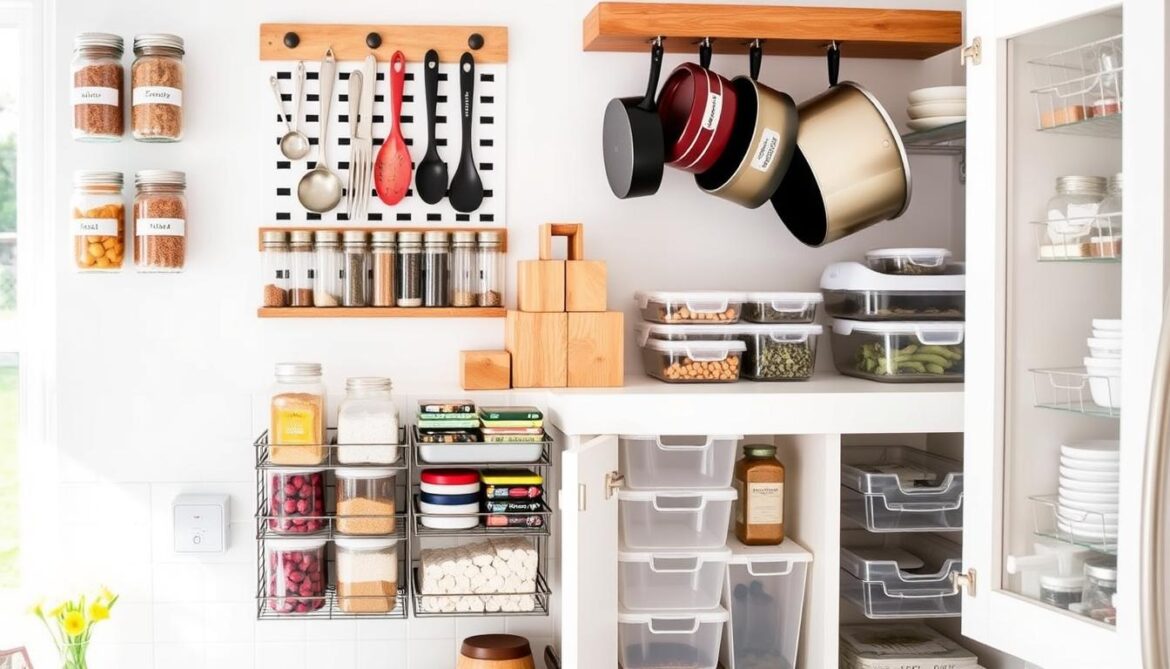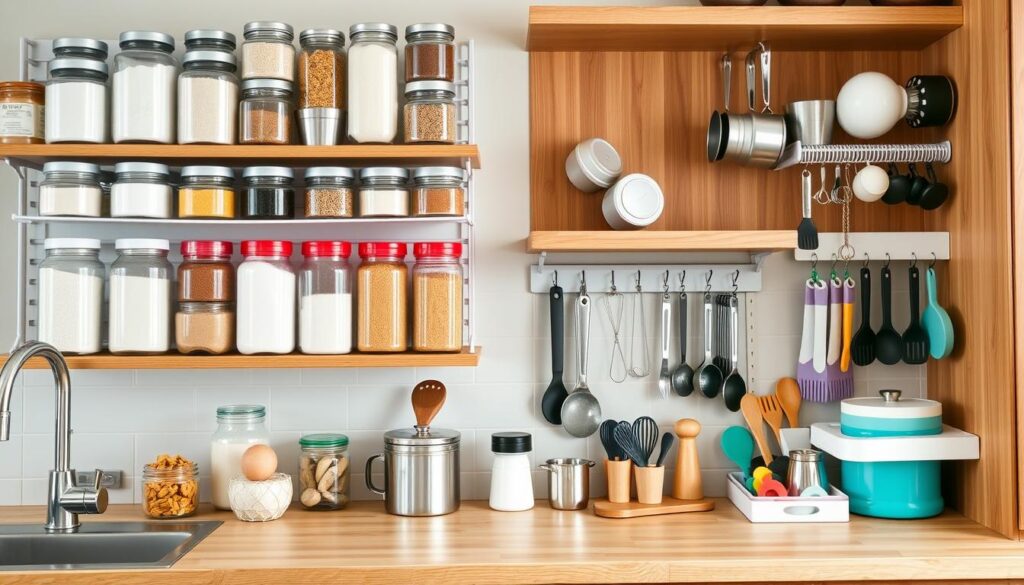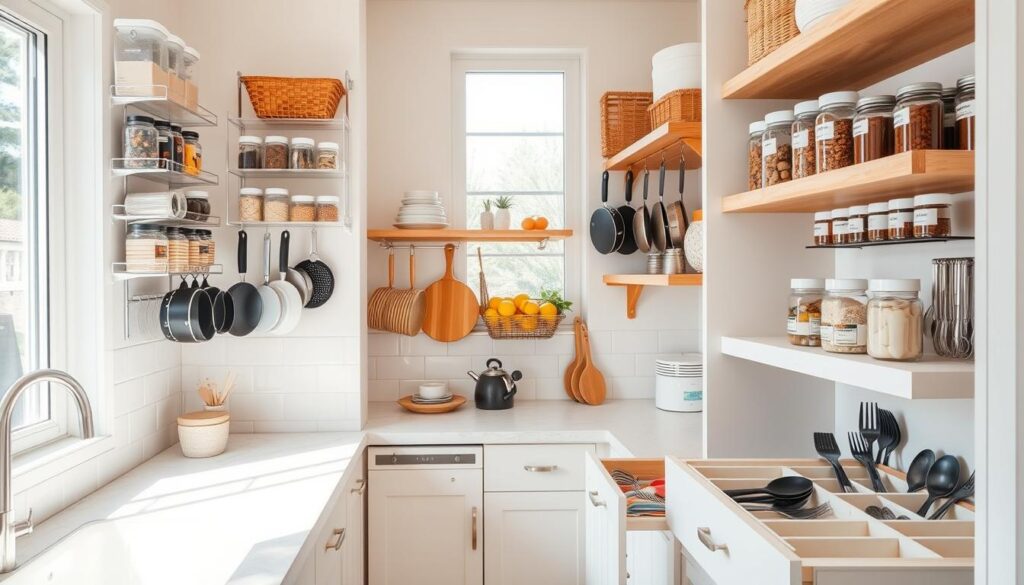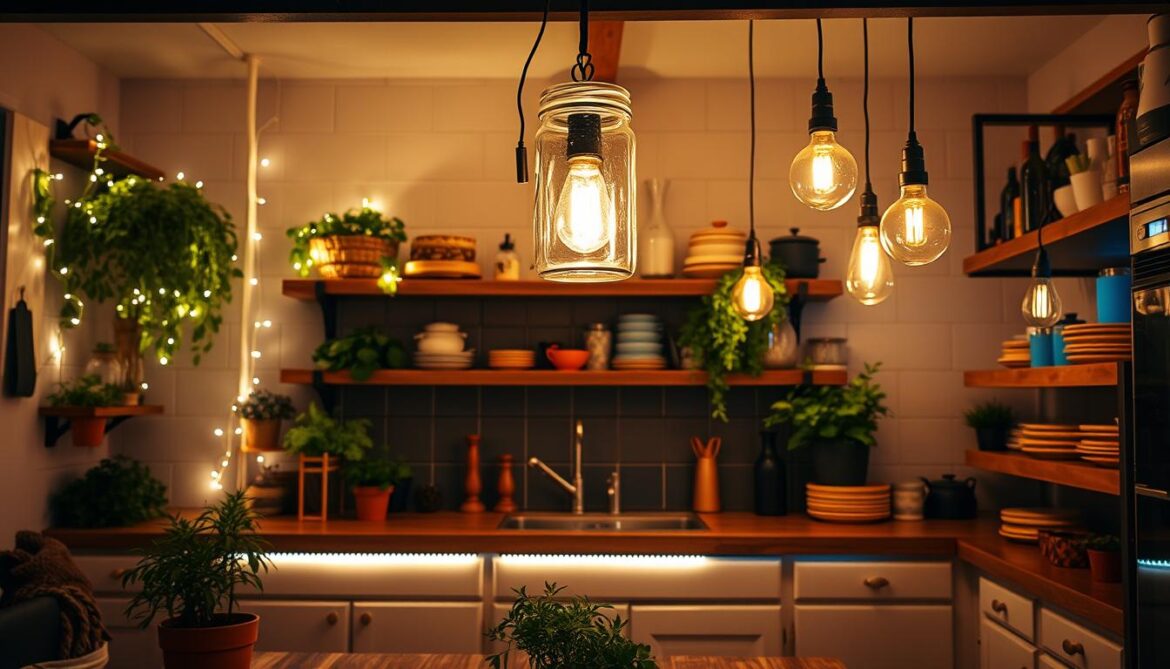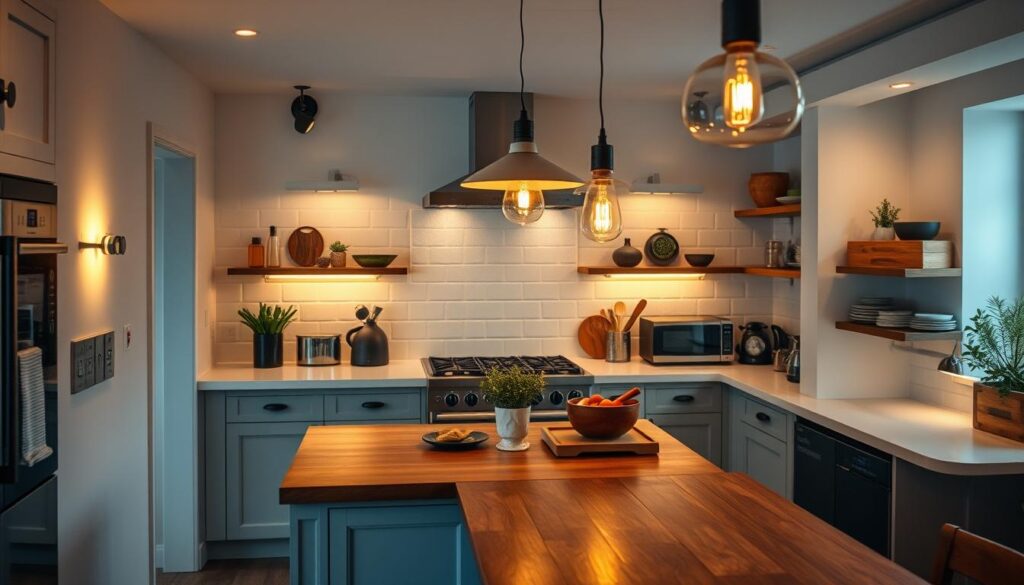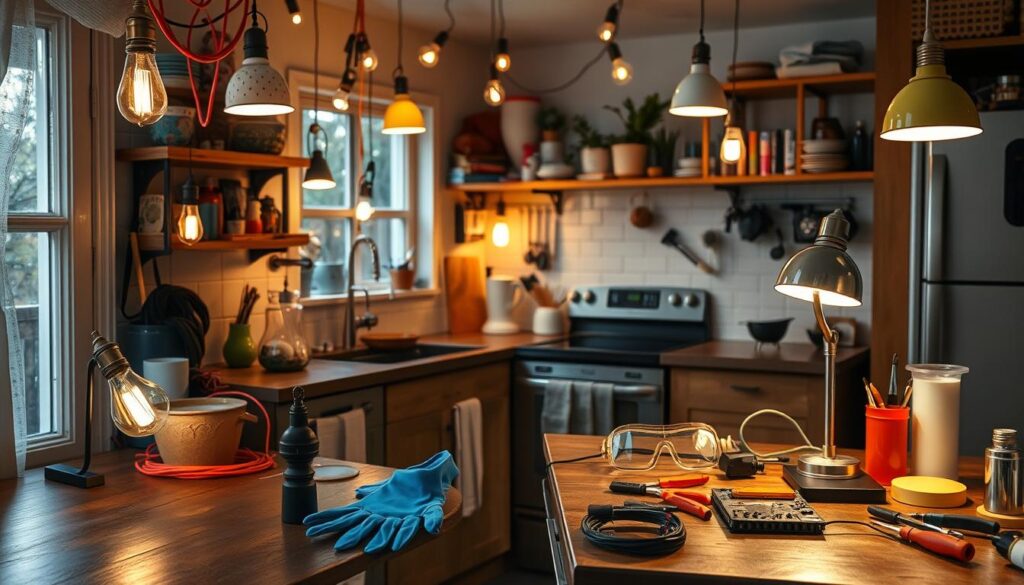Imagine walking into your kitchen and feeling calm and in control. Everything you need is right where you need it. DIY Kitchen Organization can make this happen. It turns your kitchen into a place where cooking is a pleasure.
These top 15 DIY Kitchen Organization hacks will show you how to use your space better. You’ll learn to reduce clutter and make your kitchen work for you. From smart storage to pantry systems, these hacks make your kitchen both pretty and practical.
Using these DIY Kitchen Organization hacks, you’ll make cooking easier and faster. You’ll save time and feel less stressed. These hacks are perfect for busy people or serious cooks. They make your kitchen fit your needs and preferences, maximizing your DIY efforts.
Maximize Your Cabinet Space
Optimizing your cabinet space can change your kitchen’s look and feel. Using smart storage ideas keeps your space tidy. It also makes it easier to find what you need.
Use Shelf Risers for Easy Access
Shelf risers add extra space up high. This lets you store more without making things too crowded. With everything at eye level, you won’t have to search through messy shelves.
Install Pull-Out Bins
Pull-out bins are great for deep corners. They make it simple to get to what’s inside. This way, you can avoid losing things in the back. They’re perfect for big items like pots and pans.
Utilize Door Space for Helpers
Don’t forget the inside of cabinet doors. Adding hooks or small racks can hold spices, utensils, or cleaning supplies. It saves space and keeps essentials within reach, making your kitchen more efficient.
Creative Drawer Organization
Make your kitchen drawers smarter with hacks that save space and boost efficiency. The right storage ideas can greatly improve your kitchen’s tidiness and function.
Drawer Dividers to the Rescue
Drawer dividers keep items apart, stopping clutter and making things easier to find. You can tailor the spaces for utensils, gadgets, and other tools.
Use Small Baskets for Clutter Control
Small baskets are great for organizing similar items. They keep things tidy and add style to your drawers. Use them for tea bags, baking stuff, or snacks.
Labeling for Quick Identification
Labels help you find things fast by keeping them in their place. Use handwritten or printed labels for clear identification. This saves time when you’re cooking.
| Storage Idea | Benefits | Implementation Tips |
|---|---|---|
| Drawer Dividers | Prevents clutter, easy access | Adjustable dividers for flexibility |
| Small Baskets | Groups similar items, decorative | Choose baskets that fit drawer size |
| Labeling | Quick identification, maintains order | Use clear and consistent labeling |
Innovative Use of Wall Space
Using your kitchen’s vertical space can really help with DIY Kitchen Organization and decluttering countertops. By smartly using walls, you can store more items and keep your kitchen neat.
Magnetic Strips for Utensils
Magnetic strips are great for keeping metal utensils handy. They save drawer space and let you show off your favorite tools.
Pegboards for Tools and Accessories
Pegboards are perfect for storing kitchen tools and accessories. You can arrange them with hooks and shelves, fitting items of all sizes.
Floating Shelves for Decor
Floating shelves offer storage and a chance to decorate. They’re perfect for showing off cookbooks, plants, or decorative items, adding personality to your kitchen.
| Organization Method | Benefits | Best For |
|---|---|---|
| Magnetic Strips | Easy access, Saves drawer space | Knives, Metal Utensils |
| Pegboards | Customizable, Versatile | Mix of Tools and Accessories |
| Floating Shelves | Decorative, Dual-purpose | Cookbooks, Plants, Decorative Items |
Smart Pantry Solutions
Make your pantry smarter with these ideas. They boost both function and looks. Good organization hacks help you cook better and waste less food.
Clear Bins for Visibility
Clear bins let you see everything in your pantry. This makes finding ingredients fast and easy. Plus, they help you keep track of what you have, so you don’t buy too much.
Tiered Stacking for Efficient Use
Use tiered stacking to save space in your pantry. It uses vertical space well and keeps things you use often easy to get. It’s great for canned goods, spices, and snacks.
Labels to Keep It All Straight
Labeling your containers is a smart move. Clear labels help everyone know where things go. This keeps things tidy and makes restocking simple. It also helps you see what you have and what you need.
DIY Storage Containers
Make your kitchen more organized with DIY storage containers. They save space and add a personal touch. It’s a great way to declutter and organize your kitchen.
Repurpose Glass Jars for Bulk Items
Glass jars are great for storing bulk items. They let you see what’s inside, making it easy to find what you need.
- Grains like rice and quinoa
- Pasta and noodles
- Beans and lentils
- Spices and herbs
Customized Boxes for Small Goods
Customized boxes are perfect for small items. You can make them fit your kitchen’s style and needs.
- Tea bags and coffee pods
- Baking supplies like measuring spoons and cups
- Snacks and treats
- Kitchen gadgets and utensils
| Storage Solution | Benefits | Best For |
|---|---|---|
| Glass Jars | Visibility, airtight, reusable | Bulk grains, spices |
| Customized Boxes | Personalized size, aesthetic appeal | Small goods, utensils |
Efficient Use of Counter Space
Maximizing your kitchen’s counter space can change how you cook. Smart organization hacks keep essentials handy without clutter. This makes your kitchen more efficient.
Multi-Purpose Storage Solutions
Choose storage that does more than one thing. For example, a spice rack can hold small jars too. Or, a utensil holder can fit both cooking tools and gadgets. This way, you need fewer items on your counter, keeping it neat and organized.
Decorative Trays to Group Items
Decorative trays help organize similar items. Putting oils, spices, and vinegars on one tray makes them easy to find. It also adds style to your kitchen. These trays also make cleaning easier and keep things looking good.
| Storage Idea | Description | Benefits |
|---|---|---|
| Magnetic Knife Strips | Mount knives on a magnetic strip to free up drawer space. | Safe storage and easy access |
| Under-Cabinet Hooks | Hang mugs or utensils beneath cabinets. | Utilizes vertical space efficiently |
| Tiered Canisters | Stackable containers for storing dry goods. | Maximizes shelf space and improves visibility |
Organize Your Spices Effectively
Keeping your spices organized makes cooking easier and helps declutter your kitchen. A well-organized spice storage system can make a big difference.
Spice Racks or Drawers?
Deciding between spice racks and drawers depends on your kitchen and cooking style. Here’s a quick comparison:
- Spice Racks: They offer easy visibility and quick access, great for often-used spices.
- Drawers: They provide a sleek look and keep spices dust-free, perfect for a tidy kitchen.
DIY Magnetic Spice Jars
Use DIY Kitchen Organization to make magnetic spice jars. Attach magnetic strips to a wall or fridge. Then, place your spices in these jars for easy access and order.
| Storage Method | Benefits | Considerations |
|---|---|---|
| Spice Racks | Easy access, visible arrangement | Takes up counter space |
| Drawers | Hidden storage, streamlined look | May require customization |
| Magnetic Spice Jars | Space-efficient, modern look | Requires magnetic surface |
Streamlined Cooking Tools Storage
Organizing your cooking tools can change how you use your kitchen. Smart hacks help you use space better and work more efficiently.
Hanging Rods for Pots and Pans
Hanging rods for pots and pans save cabinet space. This idea keeps your cookware handy and adds style to your kitchen. Just hang your items on a sturdy rod to tidy up your cooking area.
Container Solutions for Cooking Utensils
Using containers for utensils keeps everything in order. Drawer dividers or countertop organizers are great for this. They make cooking faster and more fun by keeping things easy to find.
Cleverly Store Baking Supplies
To get your kitchen in order, focus on DIY Kitchen Organization, mainly for baking supplies. A messy baking area can turn making a cake or cookies into a hassle. With a few smart storage ideas, you can tidy up your baking space and boost efficiency.
Using a rolling cart is a smart move for storing baking supplies. It keeps essentials like flour, sugar, and baking powder within easy reach. You can also stash your mixing bowls, measuring cups, and other baking tools on it. This way, you’ll make baking faster and more fun.
Use a Rolling Cart for Easy Access
Don’t forget about vertical storage for your cookbooks. It keeps your countertops free and makes finding recipes easier. A bookshelf or storage unit with baskets is perfect for organizing your cookbooks.
Vertical Storage Solutions for Cookbooks
These storage tips will help you create a better baking area. Always clean up your baking supplies and storage to keep things neat and useful. With some creativity and planning, you can set up a DIY Kitchen Organization system that makes baking a pleasure.
Fridge Organization Made Easy
Keeping your fridge organized can make meal prep easier and cut down on food waste. Smart storage ideas help you find what you need quickly.
Clear Containers for Snacks and Meals
Clear containers let you see what’s inside without opening them. This organization hack saves time by making it easy to find snacks or ingredients. It makes your kitchen more efficient.
Utilize Door Compartments Wisely
The door is great for items you use often. Put condiments, drinks, and snacks there to save space. Organizing door compartments well is a key storage idea for a clean fridge.
Kids’ Kitchen Area Organization
Organizing a kitchen for kids helps them become independent and keeps things neat. Smart DIY hacks can make a kid-friendly space. This encourages kids to take responsibility.
Low-Height Storage for Accessibility
Put in lower cabinets or shelves for easy reach of utensils and cookware. Use step stools with safety rails for safe access. This helps kids become self-sufficient while you clean up the main kitchen.
Create a Snack Station
Set up a snack station for a specific snack area. Use clear containers and labels for healthy snacks. This lets kids pick their own snacks easily, keeping the kitchen tidy and teaching them to make choices.
| Storage Solution | Benefits |
|---|---|
| Low Shelved Cabinets | Easy access promotes independence |
| Clear Snack Containers | Visibility encourages organization |
| Labelled Jars | Quick identification reduces clutter |
Seasonal Storage Strategies
As the seasons change, so do your kitchen needs. Smart organization hacks and storage ideas can keep your kitchen clutter-free all year. By changing your storage with the seasons, you make sure only the essentials are easy to find.
Use Vacuum-Sealed Bags
Vacuum-sealed bags are a big help for storing items you don’t use often. They save space and keep things safe from moisture and pests. Whether it’s holiday bakeware or seasonal gadgets, these bags keep your kitchen tidy and your tools in great shape.
Rotate Items Seasonally
Rotating your kitchen tools and gadgets with the seasons is a smart move. Keep summer grilling essentials ready when it’s warm and switch to winter baking tools when it’s cold. This way, you use your space better and keep your kitchen organized all year.
| Season | Items to Store or Rotate |
|---|---|
| Spring | Herb gardens, fresh produce containers |
| Summer | Grilling tools, summer dishware |
| Fall | Soup makers, autumn-themed decor |
| Winter | Baking sets, holiday-specific cookware |
Additional Tips for Maintenance
Keeping your kitchen organized is a big win. But, the real test is keeping it that way over time. To keep your kitchen in top shape, try a few simple maintenance tips.
Schedule Regular Decluttering Sessions
Set aside time each month or season to sort through your kitchen. Look for items you no longer need or use. Get rid of them by donating, recycling, or throwing them away. This stops clutter from coming back.
DIY kitchen organization
By doing this, you’ll keep your kitchen organized for longer.
Embrace the One-In-One-Out Rule
Use the one-in-one-out rule to stop clutter buildup. When you add something new, take away something old that does the same thing. This keeps your space balanced and organized.
declutter
This way, your hard work won’t go to waste.
By making these habits part of your routine, your kitchen will stay organized for years. Keep it up, and your kitchen will keep working for you without hassle.
FAQ
What are the key benefits of implementing DIY kitchen organization hacks?
DIY kitchen hacks offer many benefits. They help you use your space better and reduce clutter. Your kitchen will work more efficiently and look better.
It’s easier to find what you need. You’ll also waste less food by keeping track of what you have. Your kitchen will look neat and organized.
How can I maximize my cabinet space with these organization hacks?
To use your cabinet space better, start with shelf risers. They add extra storage up high. Then, add pull-out bins for easy access to corners.
Don’t forget the door space. Use it for small tools and helpers.
What are some effective ways to organize my kitchen drawers?
To organize your drawers, use dividers. They help keep things in their place. Small baskets or bins also help keep clutter away.
Labeling drawers and containers makes it easy to find what you need. This keeps your kitchen tidy.
How can I make the most of my kitchen’s wall space?
To use your walls well, install magnetic strips. They hold utensils within reach. A pegboard system is great for hanging tools and gadgets.
Adding floating shelves is another good idea. They display decor and store items you don’t use often.
What are some effective pantry organization solutions?
To organize your pantry, use clear bins. They let you see what’s inside. Tiered stacking makes the most of vertical space.
Labeling containers and shelves keeps everything in order. This makes finding what you need easy.
How can I create DIY storage containers for my kitchen?
To make DIY storage, repurpose glass jars. They’re great for storing grains and pasta. You can also customize boxes or containers for smaller items.
What are some ways to efficiently use my kitchen counter space?
To use your counter space well, choose multi-purpose storage. It keeps items you use often handy. Grouping related items on decorative trays keeps things tidy.
How can I organize my spices effectively?
To organize spices, decide between racks or drawers. It depends on your kitchen’s layout. DIY magnetic spice jars are a good choice for easy access.
How can I streamline the storage of my cooking tools and utensils?
To organize your tools and utensils, install hanging rods or racks. They keep pots, pans, and lids organized. Use container solutions like utensil holders or drawer dividers to keep things tidy.
How can I store my baking supplies and cookbooks efficiently?
To store baking supplies and cookbooks, use a rolling cart. It keeps items you use often within reach. Vertical storage solutions like shelves or racks are good for cookbooks.
How can I organize my refrigerator effectively?
To organize your fridge, use clear storage containers. They’re great for snacks, meals, and leftovers. Use the door compartments for items you use often.
How can I create an organized kitchen area for kids?
To organize a kitchen for kids, use low-height storage. It makes items easy for them to reach. A dedicated snack station with kid-friendly options is also a good idea.
What seasonal storage strategies can I use in my kitchen?
To store seasonal items, use vacuum-sealed bags. They keep items you don’t use often fresh. Rotate your tools and gadgets with the seasons.
How can I maintain the organization of my kitchen long-term?
To keep your kitchen organized, schedule regular decluttering sessions. Remove items you don’t need. The one-in-one-out rule helps prevent clutter.
